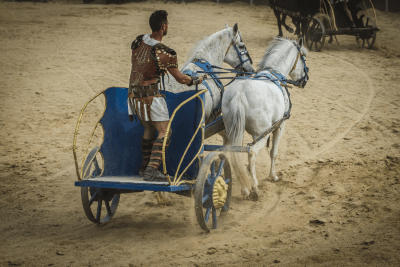

People often use it as a place to hold meetings and concerts. Today the sight of the circus is a large public park. A charioteer (or horse) who had won more than a thousand races was called a militaries. The most famous winner of all, with more than 2,000 race victories, was Scorpus. The crowd was placing huge bets on the games and the victorious charioteers not only become rich, but they also became the darlings of the crowd. Chariot racing was the most popular spectator sport in ancient Rome, even more popular than the gladiators combats. They had to circle the Spine 7 times- a total distance of about 11km. Charioteers wore leather helmets and jerkins in the colors of their faction (green, blue, red or white). The chariots themselves were colour-coded (red, white, green and blue) and could be pulled by teams of 4, 6, 8 or 12 horses. It would have been like driving a basket on wheels.
FACTS ABOUT CHARIOT RACES FREE
Admission to the Circus Maximus was free and all levels of Roman society, from the emperor to the urban poor, came to see the chariot races.Ĭhariots were very light, probably made of leather, so they could go as fast as possible. Private boxes were made also for politicians, important military personnel and senators. Due to the fact that the Palatine Hill was the home of the royal families and the Emperor, an imperial box was built high up for them in the palace area on the hill.


The Circus is situated between the Palatine and the Aventine hills. Giovanni in Laterano.At its largest during the 1st century CE following its rebuilding after the fire of 64 CE, this large arena with length at 621m.(2,037ft.) and width at 118m.(387ft.) had a capacity for more than 250,000 people (one quarter of Rome’s population at that time).The spectators were seated on banks 30m. Nowadays they can be seen in Piazza del Popolo and Piazza S. The spina also had two obelisks added over the centuries, one in the centre and one at the end.įirst excavations were during the papacy of Sixtus ˅ in 1587 and the two obelisks of the spina were recovered. A decorated barrier (spina or euripus) ran down the centre of the track, so that chariots ran in a circuit around conical turning posts (metae) placed at each end. Shops outside the circus would have served the needs of the spectators. The lower part of the seating area was built in marble. The lowest were made of concrete and stone and wood for the rest. The stadium was surrounded with rows of seats all around, 3 stories high. and various improvements were made to the design of this massive arena. It was first constructed in 6 century BC. The popular chariot races were held here for almost a millennium. It was designed for chariot races (ludi cercenses), but also other events were held there including gladiatorial combats (ludi gladiatorii) and animal hunts, some of which were exotically spectacular in the extreme, such as when Pompey organized a contest between a group of barbarian gladiators and 20 elephants. The Circus of Maxentius is considered the largest stadium in ancient Rome and the first stadium built by the Romans. Interesting facts about Rome’s oldest stadium and the greatest and largest Stadium in mankind history – the “Circus Maximus”. Deya Nedeva AugAncient Rome, Monuments in Rome


 0 kommentar(er)
0 kommentar(er)
